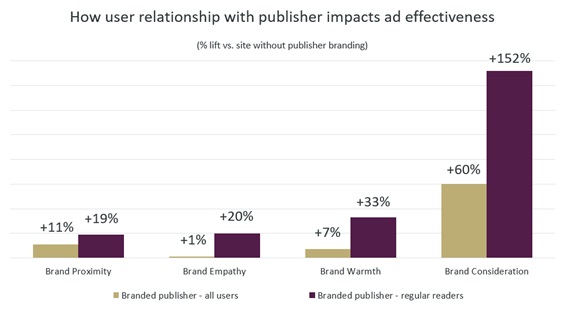The relationship a reader has with a publisher has far more impact on the effectiveness of online ads than the surrounding editorial content, which suggests concerns around brand safety may be misunderstood, according to a new study.
The study – by Inskin Media, Research Now and Conquest Research – compared the conscious and subconscious reactions of 4,370 people, who were served ads on websites either with or without publisher branding. It revealed that ads on the publisher-branded sites increased consideration for the advertiser by 60% compared to the ads on the site without publisher branding.
Furthermore, among readers with a close relationship to the publisher, consideration for the advertiser was 152% higher than among those who saw the ads on the site without publisher branding. Alongside this, advertiser brand warmth was 33% higher, brand empathy 20% higher and brand proximity (how close people felt to the brand) 19% higher.
E.g. Brand proximity sentiment towards the ad among visitors to the branded publisher site was 11% higher than among those who saw the ads on the site without publisher branding
“The relationship a publisher has with a visitor can have a catalytic effect in terms of boosting the effectiveness of the ads it carries, which reveals an important lesson,” said Steve Doyle, Inskin Media’s CCO. “It shows that if online publishers pay more consideration to the reader experience, particularly in regards to advertising, the ads will be more effective, so they can charge a higher premium while carrying less advertising – a virtuous circle.”
In contrast, there was no systematic pattern to suggest that editorial content impacts the ad – be the article positive or negative or whether it had a similar theme to the ad. For example, a food ad next to an article about obesity did not overtly affect any brand metrics at all. Also, in isolated cases, a story that was both positive and had a similar theme to the ad could still elicit a negative brand association, suggesting individual parts of the article could have a disproportionate effect.
Doyle says this shows that brand safety is “considerably more complex than the industry might like to admit. For example, we know brand safety is a “PR” issue but what effect does it actually have on how readers actually perceive the brand and act on it? Without a doubt, more research in this area is required to help marketers devise meaningful and effective brand safety policies, as the area is still a relative unknown.”
Methodology
Inskin Media and Research Now commissioned research agency Conquest to carry out an online test with multiple brands, display formats and publishers. From July – August 2017, a nationally representative sample of 4,364 UK respondents was surveyed using both explicit and implicit measurement methodologies in order to uncover both conscious and subconscious associations people held of the brands tested.

